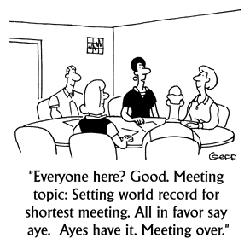Which of the following adjectives would you use to describe Board meetings at your company?
Dull? Dreary? Disappointing? Dire? Dysfunctional?
Entrepreneurial? Enlightening? Enthusiastic? Exciting? Effective?
My suspicion is that many owner managers, managing directors  or CEOs of small and medium-sized businesses (SMEs) might be tempted to select one from the top list. If that’s you, do you ever wonder if there is any point in having regular board meetings? Can you afford the time, resource and cost?
or CEOs of small and medium-sized businesses (SMEs) might be tempted to select one from the top list. If that’s you, do you ever wonder if there is any point in having regular board meetings? Can you afford the time, resource and cost?
Let’s look under the hood of BoDs.
Regulatory requirements
While it is relatively straight forward for a single individual to establish a UK Limited Company and become its sole director and shareholder, it is a legal entity which creates duties and responsibilities, enshrined in the Companies Act 2006, with the potential for personal liabilities and even penalties.
The articles of association delegate the management of a company to its board of directors. They describe how decisions are to be made and how the board is to operate, commonly referred to as Corporate Governance.  In essence you need a board meeting whenever you need to take a decision which requires board approval, to comply with legislation, whenever a director requests a board meeting or to approve the annual accounts. The need for an effective board will increase in proportion to the number of shareholders, especially if they are external.
In essence you need a board meeting whenever you need to take a decision which requires board approval, to comply with legislation, whenever a director requests a board meeting or to approve the annual accounts. The need for an effective board will increase in proportion to the number of shareholders, especially if they are external.
SME boards in practice
As a director you need to ensure that the number of board meetings held, the subjects on the agenda and the way meetings are conducted, demonstrate that you are complying with your duties as a director. For example, that each of you is promoting the long-term success of the company and exercising independent judgement. Although some SMEs may pay lip service to board meetings, many hold regular meetings, scheduled quarterly or monthly.
The role of the board
The board has several distinct roles including:
- Leadership – creating a culture of excellence
- Setting strategy – the orientation of the board ought to be about the future; the direction of the business as opposed to its past performance
- Ensuring human and financial resources are in place
- Reviewing management performance
- Establishing company values and standards
- Ensuring obligations to shareholders and other stakeholders are understood and met
There are three types of board member, all of whom share the same duties but bring a different perspective. These three roles are:
Chair
a. Leads the board
b. Sets the agenda
c. Ensures the board is an effective working group
d. Promotes a culture of openness and debate
e. Ensures effective communications with shareholders
f. Ensures all directors receive accurate, timely and clear information
Executive Director
Has an operational role in the business and typically will represent and speak to the issues around a function, division or business area. Directors all share the following 7 duties:
1. Act within powers
2. Promote the success of the company
3. Exercise independent judgement
4. Exercise reasonable care, skill, and diligence
5. Avoid conflicts of interest
6. Not to accept benefits from third parties
7. Declare interest in proposed transaction or arrangement
Non-Executive Director (NED)
There is no legal requirement to appoint a NED, although it is considered good practice. A NED has the same duties as an Executive Director, but has additional roles given s/he is not involved with day to day operations. A NED will add value to the business if s/he is able to:
a. Constructively challenge
b. Help develop strategic proposals
c. Scrutinise management performance to ensure achievement of goals and targets
d. Ensure financial controls and risk management processes are in place
e. Determine appropriate remuneration
f. Assist with succession planning and the appointment of Exec Directors
From “bored” to “bullish”
What should you do to fix your boring board? Is it possible to move from “average” to “awesome”? Here are my five steps to boardroom effectiveness.
a. Take the temperature! Complete a board audit, including the views of all participants, to establish what is and what is not working. On the basis of your findings give the board an opportunity to discuss what should be done to enhance its effectiveness. Develop an improvement plan and implement it promptly.
b. Review the composition of the board to ensure that it includes the right mix of people, skills and experience. Consider appointing a non executive director to provide a fresh, external perspective and a complementary range of skills and experience
c. Clarify and communicate to all board members their duties and responsibilities as directors. Implement a development plan for individual directors and the entire board, to build skills, develop trust, enhance communication and improve decision-making.
d. Stop looking in the rear view mirror.  It’s a board, not a production or sales meeting! Adjust the agenda and timing to devote more time to strategic issues and priority topics. Keep it focused, short and on track. Develop, or recruit, a chairperson who can lead the board effectively while enabling all members to contribute freely.
It’s a board, not a production or sales meeting! Adjust the agenda and timing to devote more time to strategic issues and priority topics. Keep it focused, short and on track. Develop, or recruit, a chairperson who can lead the board effectively while enabling all members to contribute freely.
e. Get the basics right. Agree the meeting dates well in advance and monitor attendance; it’s not an optional event. Provide board papers at least one week in advance and insist people come to each meeting fully prepared and ready to contribute.
If you have a great board tip, please share it in the comment section.

